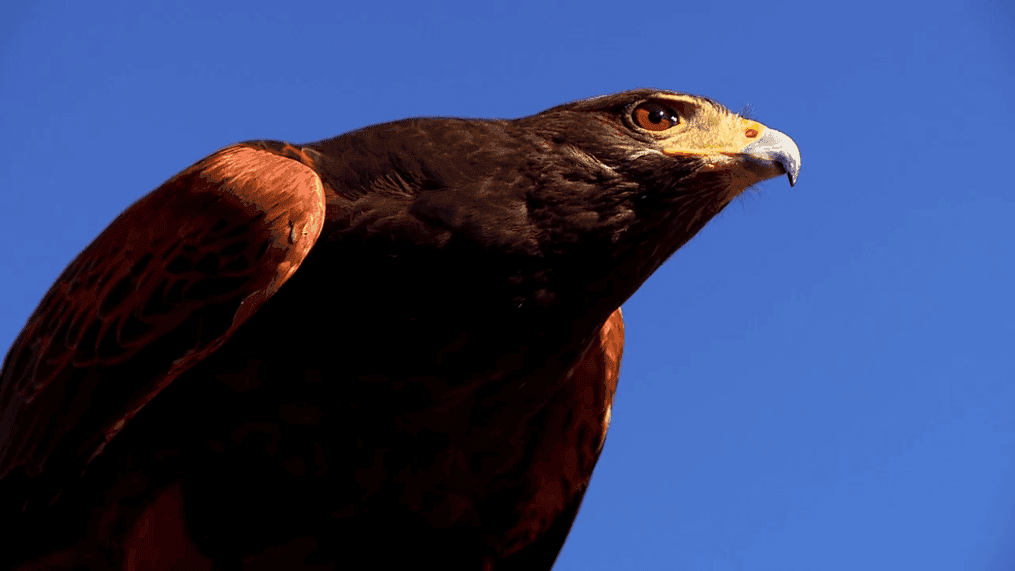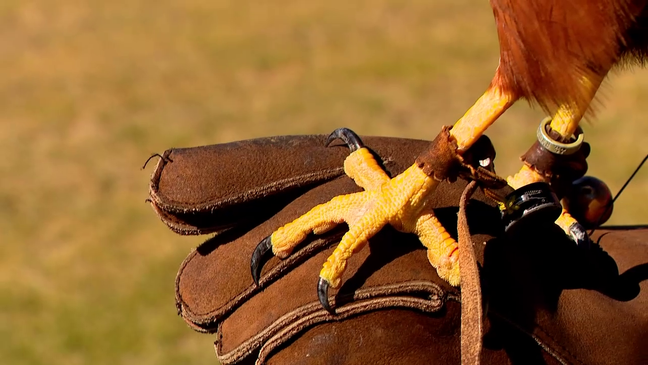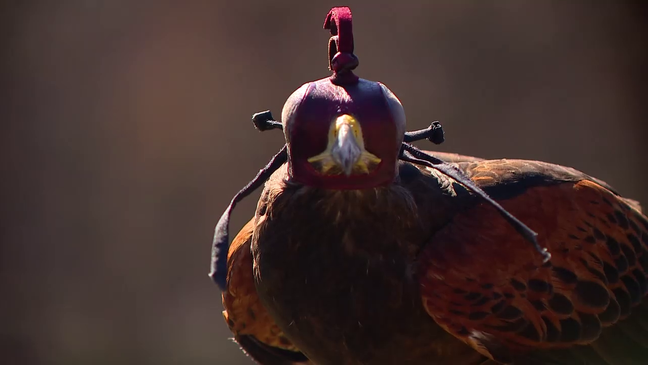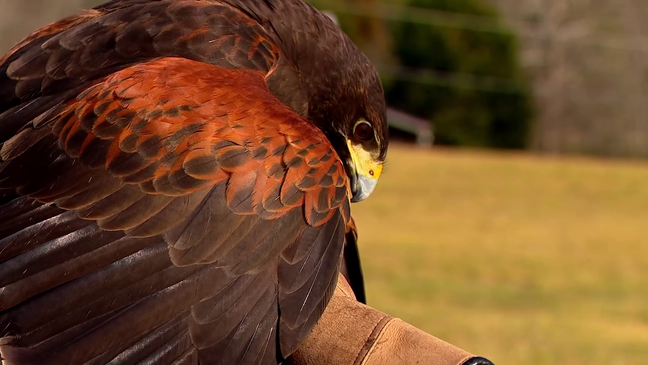Passed down for generations, the art of falconry continues in North Carolina
WEAVERVILLE, N.C. (WLOS) – It is second only to dogs as the oldest working relationship between humans and animals.
{sd-embed class="sd-embedded-media" data-alt="WLOS" data-caption="Passed%20down%20for%20generations,%20the%20art%20of%20falconry%20continues%20in%20North%20Carolina%20(WLOS)" data-duration="211" data-externalid="bf6a2cfa18c244529af69eaf8374923c" data-mediatype="video" data-renditions="" data-thumburl="https://sinclair-vod-assets.sinclairstoryline.com/bf6a2cfa18c244529af69eaf8374923c/thumbnails/poster.jpg" data-title="Passed%20down%20for%20generations,%20the%20art%20of%20falconry%20continues%20in%20North%20Carolina" data-url="https://sinclair-vod-assets.sinclairstoryline.com/bf6a2cfa18c244529af69eaf8374923c/hls/index.m3u8" data-defaultthumb="true" data-embed-file="%3Cdiv%20class=%22sda-VideoEmbed%22%3E%0A%20%20%20%20%20%20%20%20%20%20%20%20%3Cdiv%20class=%22sda-video-media-no-thumb%22%3E%0A%20%20%20%20%20%20%20%20%20%20%20%20%3Ciframe%0A%20%20%20%20%20%20%20%20%20%20%20%20%20%20%20%20width=%22560%22%0A%20%20%20%20%20%20%20%20%20%20%20%20%20%20%20%20height=%22315%22%0A%20%20%20%20%20%20%20%20%20%20%20%20%20%20%20%20class=%22sda-embeded-player-iframe%20sda-VideoEmbed-iframe%22%0A%20%20%20%20%20%20%20%20%20%20%20%20%20%20%20%20src=%22/resources/embeds/vod.html?externalId=bf6a2cfa18c244529af69eaf8374923c&thumbUrl=https%253A%252F%252Fsinclair-vod-assets.sinclairstoryline.com%252Fbf6a2cfa18c244529af69eaf8374923c%252Fthumbnails%252Fposter.jpg%22%0A%20%20%20%20%20%20%20%20%20%20%20%20%20%20%20%20frameborder=%22no%22%3E%0A%20%20%20%20%20%20%20%20%20%20%20%20%3C/iframe%3E%0A%20%20%20%20%20%20%20%20%20%20%20%20%3Cdiv%20class=%22sda-VideoEmbed-caption-no-thumb%22%3E%0A%20%20%20%20%20%20%20%20%20%20%20%20%20%20%20%20%20%20%20%20%3Cspan%3ECaption:%20Passed%20down%20for%20generations,%20the%20art%20of%20falconry%20continues%20in%20North%20Carolina%20(WLOS)%3C/span%3E%0A%20%20%20%20%20%20%20%20%20%20%20%20%20%20%20%20%3C/div%3E%0A%20%20%20%20%20%20%20%20%3C/div%3E%0A%20%20%20%20%20%20%20%20%20%20%20%20%0A%20%20%20%20%20%20%20%20%3C/div%3E" data-embed-type="video" contenteditable="false"}{/sd-embed}
From its ancient beginnings in the Middle East, falconry is practiced on all continents, and falconers worldwide have passed along their knowledge and skills for nearly 200 generations, bringing the art to Western North Carolina.
For Master Class Falconer Jeff Curtis, rehabilitating raptors at Furman University grew into a life’s work with birds of prey. Curtis was part of a club on campus.
“We had a vet that we worked with and the students would clean enclosures and cages," he said. "I volunteered to be part of that and just loved doing it. I made a little bit of rudimentary falconry equipment so we could exercise some of the birds before we released them. I think I got to release a dozen or so birds.”
For Apprentice Class Falconer Sam Bristow, the passion for falconry began on an outing with Curtis. Bristow and her husband were new to Asheville and “just looking for something cool to do together" in their new hometown.
Bristow had a goal to have a job where she was always learning and in nature every day. The opportunity to become Curtis' apprentice was that job that truly hit the jackpot.
{sd-embed class="sd-embedded-media" data-alt="FALCONRY%20FOR%20WEB%20CLIP%202" data-caption="Apprentice%20Class%20Falconer%20Sam%20Bristow%20shares%20more%20about%20the%20logistics%20of%20trapping%20birds%20of%20prey%20and%20how%20she%20and%20Jeff%20Curtis%20were%20able%20to%7B%7Dtrap%20a%20red-tailed%20hawk%20she%20later%20named%20Sailor.%20(WLOS)" data-duration="89.34400000000005" data-externalid="54857932592c45789f42c10e9388c445" data-mediatype="video" data-renditions="" data-thumburl="https://sinclair-vod-assets.sinclairstoryline.com/54857932592c45789f42c10e9388c445/thumbnails/poster.jpg" data-title="Passed%20down%20for%20generations,%20the%20art%20of%20falconry%20continues%20in%20North%20Carolina" data-url="https://sinclair-vod-assets.sinclairstoryline.com/54857932592c45789f42c10e9388c445/hls/index.m3u8" data-defaultthumb="true" data-embed-file="%3Cdiv%20class=%22sda-VideoEmbed%22%3E%0A%20%20%20%20%20%20%20%20%20%20%20%20%3Cdiv%20class=%22sda-video-media-no-thumb%22%3E%0A%20%20%20%20%20%20%20%20%20%20%20%20%3Ciframe%0A%20%20%20%20%20%20%20%20%20%20%20%20%20%20%20%20width=%22560%22%0A%20%20%20%20%20%20%20%20%20%20%20%20%20%20%20%20height=%22315%22%0A%20%20%20%20%20%20%20%20%20%20%20%20%20%20%20%20class=%22sda-embeded-player-iframe%20sda-VideoEmbed-iframe%22%0A%20%20%20%20%20%20%20%20%20%20%20%20%20%20%20%20src=%22/resources/embeds/vod.html?externalId=54857932592c45789f42c10e9388c445&thumbUrl=https%253A%252F%252Fsinclair-vod-assets.sinclairstoryline.com%252F54857932592c45789f42c10e9388c445%252Fthumbnails%252Fposter.jpg%22%0A%20%20%20%20%20%20%20%20%20%20%20%20%20%20%20%20frameborder=%22no%22%3E%0A%20%20%20%20%20%20%20%20%20%20%20%20%3C/iframe%3E%0A%20%20%20%20%20%20%20%20%20%20%20%20%3Cdiv%20class=%22sda-VideoEmbed-caption-no-thumb%22%3E%0A%20%20%20%20%20%20%20%20%20%20%20%20%20%20%20%20%20%20%20%20%3Cspan%3ECaption:%20Apprentice%20Class%20Falconer%20Sam%20Bristow%20shares%20more%20about%20the%20logistics%20of%20trapping%20birds%20of%20prey%20and%20how%20she%20and%20Jeff%20Curtis%20were%20able%20to%7B%7B %7D%7Dtrap%20a%20red-tailed%20hawk%20she%20later%20named%20Sailor.%20(WLOS)%3C/span%3E%0A%20%20%20%20%20%20%20%20%20%20%20%20%20%20%20%20%3C/div%3E%0A%20%20%20%20%20%20%20%20%3C/div%3E%0A%20%20%20%20%20%20%20%20%20%20%20%20%0A%20%20%20%20%20%20%20%20%3C/div%3E" data-embed-type="video" contenteditable="false"}{/sd-embed}
All falconers begin as an apprentice working with another falconer for two years. From there, you must be recommended by your sponsor and another falconer to advance to General Class Falconer. You will spend five years at that level before you can advance to Master Class Falconer. Curtis says, “you can’t just go to Amazon and get a bird!”
Bristow and Curtis have been working together for a year now. Together, they trapped a red-tailed hawk she named Sailor. He is an immature hawk that she will work with for her two-year apprenticeship, before releasing him back into the wild.
Falconers are highly regulated. They are tested by the North Carolina Wildlife Resources Commission and biologists inspect their facilities; everything must be built to certain requirements and standards.
“We can legally go trap a wild bird and hunt with it," Curtis said. "That’s not hard, but to keep them safe and healthy in an enclosure takes a little bit of knowledge and experience. All of the regulations, they are there to benefit and to make sure the birds are well taken care of.”
The art of falconry is hunting with birds of prey. When Bristow and Custis hunt, they don’t take a rifle or a shotgun or a bow; rather, they take hawks, falcons, owls and eagles. Those are the tools – or the weapon – that kill the prey.
{sd-embed class="sd-embedded-media" data-alt="FALCONRY%20FOR%20WEB%20CLIP%203" data-caption="Master%20Class%20Falconer%20Jeff%20Curtis%20shares%20the%20importance%20of%20respecting%20wild%20birds%20of%20prey.%20(WLOS)" data-duration="63.87200000000003" data-externalid="4326a09348e94950920dcae87a8830a6" data-mediatype="video" data-renditions="" data-thumburl="https://sinclair-vod-assets.sinclairstoryline.com/4326a09348e94950920dcae87a8830a6/thumbnails/poster.jpg" data-title="Passed%20down%20for%20generations,%20the%20art%20of%20falconry%20continues%20in%20North%20Carolina" data-url="https://sinclair-vod-assets.sinclairstoryline.com/4326a09348e94950920dcae87a8830a6/hls/index.m3u8" data-defaultthumb="true" data-embed-file="%3Cdiv%20class=%22sda-VideoEmbed%22%3E%0A%20%20%20%20%20%20%20%20%20%20%20%20%3Cdiv%20class=%22sda-video-media-no-thumb%22%3E%0A%20%20%20%20%20%20%20%20%20%20%20%20%3Ciframe%0A%20%20%20%20%20%20%20%20%20%20%20%20%20%20%20%20width=%22560%22%0A%20%20%20%20%20%20%20%20%20%20%20%20%20%20%20%20height=%22315%22%0A%20%20%20%20%20%20%20%20%20%20%20%20%20%20%20%20class=%22sda-embeded-player-iframe%20sda-VideoEmbed-iframe%22%0A%20%20%20%20%20%20%20%20%20%20%20%20%20%20%20%20src=%22/resources/embeds/vod.html?externalId=4326a09348e94950920dcae87a8830a6&thumbUrl=https%253A%252F%252Fsinclair-vod-assets.sinclairstoryline.com%252F4326a09348e94950920dcae87a8830a6%252Fthumbnails%252Fposter.jpg%22%0A%20%20%20%20%20%20%20%20%20%20%20%20%20%20%20%20frameborder=%22no%22%3E%0A%20%20%20%20%20%20%20%20%20%20%20%20%3C/iframe%3E%0A%20%20%20%20%20%20%20%20%20%20%20%20%3Cdiv%20class=%22sda-VideoEmbed-caption-no-thumb%22%3E%0A%20%20%20%20%20%20%20%20%20%20%20%20%20%20%20%20%20%20%20%20%3Cspan%3ECaption:%20Master%20Class%20Falconer%20Jeff%20Curtis%20shares%20the%20importance%20of%20respecting%20wild%20birds%20of%20prey.%20(WLOS)%3C/span%3E%0A%20%20%20%20%20%20%20%20%20%20%20%20%20%20%20%20%3C/div%3E%0A%20%20%20%20%20%20%20%20%3C/div%3E%0A%20%20%20%20%20%20%20%20%20%20%20%20%0A%20%20%20%20%20%20%20%20%3C/div%3E" data-embed-type="video" contenteditable="false"}{/sd-embed}
When people come out and participate with the two for an outing, they are practicing every part of falconry except the hunt, as only Bristow and Curtis are legally allowed to hunt. In addition to his state credentials, Curtis holds a federal permit with U.S. Fish and Wildlife. They are one of the few licensed places in the Southeastern United States where one gets to handle these birds.
On each outing,Bristow and Custis want to give people an educational and eye-opening experience with birds of prey.
Bristow said she wants to keep learning and working with different types of birds.
“It’s fun to share this experience with other people and maybe spark an interest in someone else," she said.




